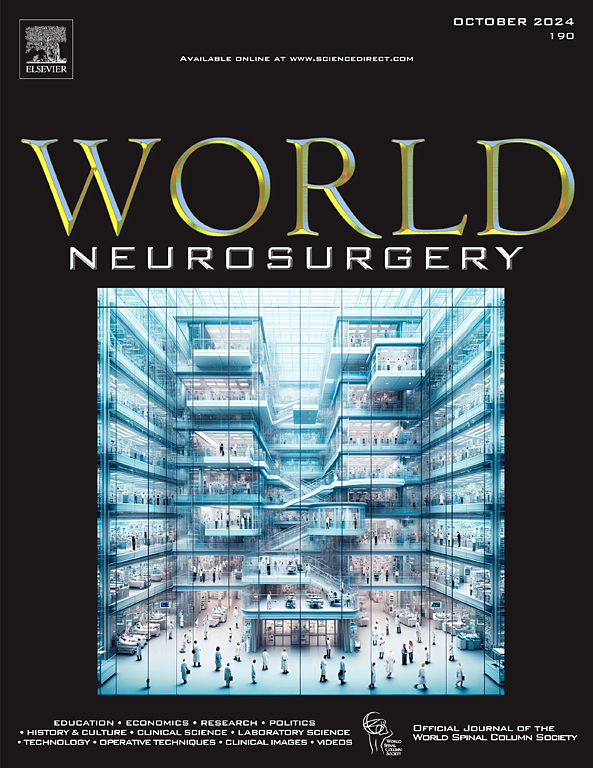21世纪的脊髓损伤第二部分:数据的不足。
IF 1.9
4区 医学
Q3 CLINICAL NEUROLOGY
引用次数: 0
摘要
在本系列的第一部分中,我们确定无骨折或脱位的脊髓损伤(SCIwoFD)已成为我们一级创伤中心最常见的脊髓损伤类型。本文的目的是检查两个数据库,一个是地方数据库,一个是国家数据库,以确定是否可以使用传统的搜索技术发现这个人口。方法分析我院对第一部分中所识别的SCIwoFD患者使用的ICD-10编码的准确性和适宜性。同时,我们查询了2015年至2019年期间的国家住院患者样本(NIS)数据库,以确定与传统的骨折/脱位相关脊髓损伤(SCI)患者相比,SCIwoFD患者的预期增加。结果我院SCIwoFD患者最常见的ICD-10诊断为颈痛(33%),其次为颈椎管狭窄(21%)。5%的人被编码为脊髓病,而中枢脊髓综合征仅被编码为2%。在NIS中,SCIwoFD仅在15%的患者中报告,而我们自己的患者中有82% (P <;0.00001)。相反,与骨折/脱位相关的脊髓损伤占所有报告的NIS csci的85%,在研究期间保持稳定在这一水平,中央脊髓综合征(7%)和创伤性脊柱病(1%)也是如此。结论我们的机构数据库和NIS都不能正确识别SCIwoFD患者。正确构建SCI特定的注册表可能是为21世纪新的SCI人口统计提供最佳实践参数的唯一机会。本文章由计算机程序翻译,如有差异,请以英文原文为准。
Spinal Cord Injury in the 21st Century Part II: Deficiencies in Data
Background
In Part I of this series we identified spinal cord injury without fracture or dislocation (SCIwoFD) as having become the most common type of spinal cord injury at our level I trauma center. The purpose of this paper was to examine two databases, one local and one national, to determine whether this population could be discovered using traditional search techniques.
Methods
We analyzed ICD-10 codes applied by our institution to SCIwoFD patients identified in Part I for accuracy and appropriateness. Concurrently, we queried the National Inpatient Sample (NIS) database between 2015 and 2019 to identify an anticipated increase in SCIwoFD patients compared to patients with more traditional spinal cord injury (SCI) associated with fracture/dislocation.
Results
The most common ICD-10 diagnosis provided for SCIwoFD patients at our institution was coded as cervicalgia (33%) followed by cervical spinal stenosis (21%). Five percent were coded for myelopathy, while central cord syndrome was coded in only 2%. Within the NIS, SCIwoFD was reported in only 15% of patients in sharp contrast to 82% of our own patients (P < 0.00001). Conversely, SCI associated with fracture/dislocation comprised 85% of all reported NIS cSCIs holding steady at this level during the study period, as did central cord syndrome (7%) and traumatic spondylopathy (1%).
Conclusions
Neither our institutional database nor the NIS allows for appropriate identification of patients suffering SCIwoFD. Properly constructed SCI-specific registries are likely to provide the only opportunity from which to establish best practice parameters for this new 21st-century demographic of SCI.
求助全文
通过发布文献求助,成功后即可免费获取论文全文。
去求助
来源期刊

World neurosurgery
CLINICAL NEUROLOGY-SURGERY
CiteScore
3.90
自引率
15.00%
发文量
1765
审稿时长
47 days
期刊介绍:
World Neurosurgery has an open access mirror journal World Neurosurgery: X, sharing the same aims and scope, editorial team, submission system and rigorous peer review.
The journal''s mission is to:
-To provide a first-class international forum and a 2-way conduit for dialogue that is relevant to neurosurgeons and providers who care for neurosurgery patients. The categories of the exchanged information include clinical and basic science, as well as global information that provide social, political, educational, economic, cultural or societal insights and knowledge that are of significance and relevance to worldwide neurosurgery patient care.
-To act as a primary intellectual catalyst for the stimulation of creativity, the creation of new knowledge, and the enhancement of quality neurosurgical care worldwide.
-To provide a forum for communication that enriches the lives of all neurosurgeons and their colleagues; and, in so doing, enriches the lives of their patients.
Topics to be addressed in World Neurosurgery include: EDUCATION, ECONOMICS, RESEARCH, POLITICS, HISTORY, CULTURE, CLINICAL SCIENCE, LABORATORY SCIENCE, TECHNOLOGY, OPERATIVE TECHNIQUES, CLINICAL IMAGES, VIDEOS
 求助内容:
求助内容: 应助结果提醒方式:
应助结果提醒方式:


